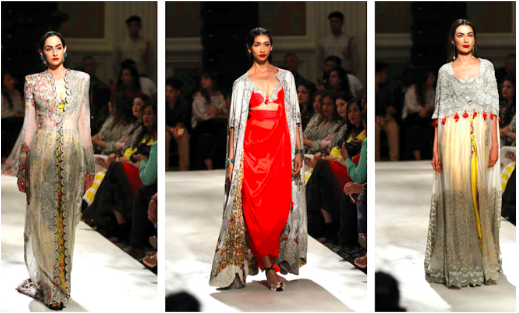Open the Secrets of Classic Eastern Put On
Exploring the enigmatic world of timeless Eastern wear looks into a realm where artistry, background, and culture assemble to develop garments that go beyond mere material and string. The intricate tapestry of practice interwoven with modern elements provides a glimpse into a world where every stitch tells a tale, every concept a symbol of importance. Introducing the secrets behind these developments introduces a tapestry of heritage waiting to be untangled, welcoming one to journey via the angelic beauty and aura of Eastern style.
History of Eastern Style
The background of Eastern style go back centuries, showing the rich cultural heritage and customs of diverse regions throughout Asia. Each area flaunts its unique designs, materials, and designs that have actually been influenced by variables like environment, faith, social standing, and trade routes. eastern wear pakistan. The detailed silk garments of China signify sophistication and refinement, while the vivid saris of India display a kaleidoscope of patterns and colors.
In Japan, the bathrobe has actually been a sign of practice and improvement for generations, with various styles used for various events. The background of Eastern style is a tapestry of technology and practice, mixing old techniques with contemporary impacts to develop a vibrant and ever-evolving sector.
Importance of Standard Clothing
Standard attire functions as a cultural symbol, embodying the worths, ideas, and heritage of areas in Eastern cultures. eastern wear pakistan. These garments are not simply items of material yet are symbolic depictions of the abundant history and traditions passed down via generations. In Eastern societies, standard outfit plays a significant function in events, events, and day-to-day live, mirroring the social status, regional associations, and also marriage standing of people
The value of standard clothing goes past aesthetic appeals; it is a means for people to attach with their roots and share pride in their social identity. Each garment, from the complex sarees of India to the streaming hanboks of Korea, lugs with it a story of workmanship, symbolism, and meaning that is deeply deep-rooted in the textile of culture.
Additionally, typical clothes functions as a visual language, connecting tales of unity, durability, and triumph. By wearing these garments, individuals not only honor their heritage but also add to the preservation and celebration of their social legacy.
Evolution of Eastern Embroideries
Eastern needleworks have a rich background that extends centuries and have actually constantly evolved to incorporate varied cultural influences and respond to shifting artistic patterns. The advancement of Eastern needleworks can be traced back to old worlds where complex designs were hand-stitched onto textiles utilizing standard techniques.

Today, Eastern embroideries proceed to progress, mixing conventional workmanship with modern style sensibilities to develop classic items that celebrate the beauty of cultural variety and imaginative innovation.
Lavish Fabrics in Eastern Use
Lavish fabrics play an essential function in elevating the aesthetic allure and top quality of Eastern wear, enhancing the total attraction and class of typical garments. Eastern wear is renowned for its luxurious fabrics that not just reflect the area's rich cultural heritage yet likewise indicate sophistication and grace.
In enhancement to silk, materials like brocade, velour, and chiffon are also frequently featured in Eastern wear. Velvet brings a deluxe and regal feel to typical ensembles, while brocade, with its metallic strings and visite site elaborate patterns, includes a touch of splendour. Chiffon, on the other hand, is preferred for its light-weight and airy qualities, making it a preferred choice for streaming shapes and fragile embellishments. These glamorous materials not only raise the aesthetic allure of Eastern wear yet also make sure a feeling of improvement and sophistication that transcends time.
Incorporating Eastern Fashion Today
In contemporary fashion landscapes, the integration of Eastern influences presents a harmonious combination of social heritage and modern aesthetics. Designers and style fanatics alike are welcoming the abundant tapestry of Eastern style, integrating standard components right into contemporary silhouettes and styles. From elaborate embroidery to lively colors and glamorous materials, Eastern fashion today offers a varied array of choices that deal with a global target market.
One means Eastern fashion is making its mark in contemporary wardrobes is through the adjustment of conventional garments such as the bathrobe, saree, or qipao right into daily wear. These pieces, once reserved for unique celebrations, are now reimagined in even more informal types, permitting their unification right into everyday fashion choices. In addition, the use of traditional patterns and concepts in Western-style apparel includes a touch of exotic elegance to modern-day attire.

Final Thought
Finally, exploring the abundant background, importance, and evolution of Eastern style reveals a deep-rooted link to heritage and values. The elegant materials and complex embroideries of Eastern put on showcase the adaptability and eternity of conventional designs. Incorporating Eastern influences in modern fashion enables a fusion of tradition and innovation, producing an unified balance between the past and the here and now.
Luxurious textiles play a pivotal review duty in boosting the aesthetic allure and quality of Eastern wear, boosting the overall attraction and class of traditional garments. Designers and style enthusiasts alike are accepting the abundant tapestry of Eastern fashion, including conventional components into contemporary silhouettes and designs. From intricate embroidery to vivid colors and lavish textiles, Eastern fashion today supplies a diverse array of choices that provide to an international audience.
One way Eastern style is making its mark in modern closets is through the adaptation of standard garments such as the bathrobe, saree, or qipao into daily wear. The lavish fabrics and elaborate needleworks of Eastern put on display the adaptability and eternity of traditional designs.
Comments on “Newest Trends in Eastern Wear Pakistan : A Comprehensive Guide for 2024”